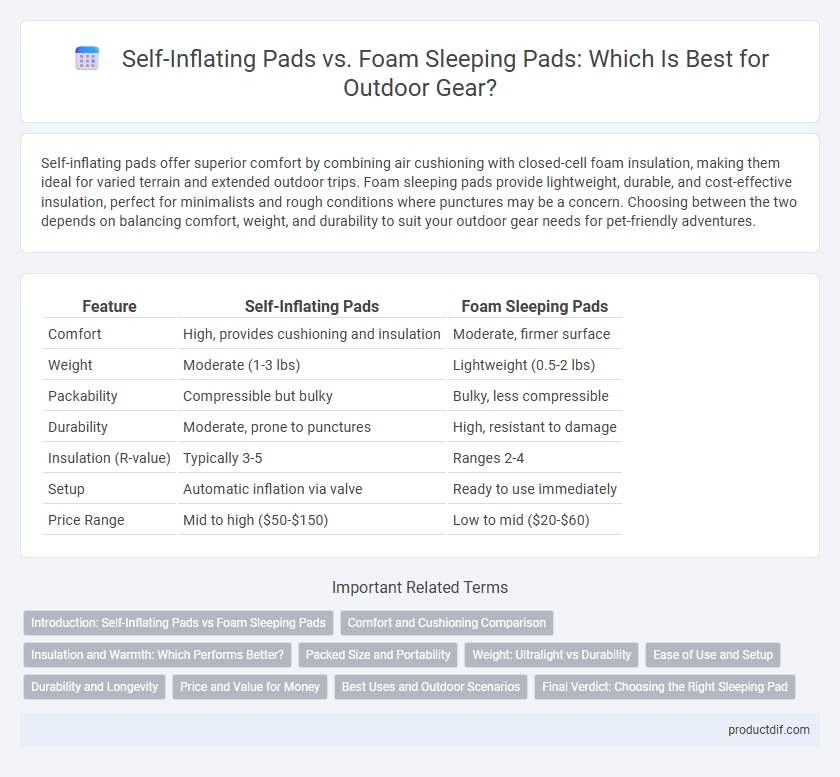Self-inflating pads offer superior comfort by combining air cushioning with closed-cell foam insulation, making them ideal for varied terrain and extended outdoor trips. Foam sleeping pads provide lightweight, durable, and cost-effective insulation, perfect for minimalists and rough conditions where punctures may be a concern. Choosing between the two depends on balancing comfort, weight, and durability to suit your outdoor gear needs for pet-friendly adventures.
Table of Comparison
| Feature | Self-Inflating Pads | Foam Sleeping Pads |
|---|---|---|
| Comfort | High, provides cushioning and insulation | Moderate, firmer surface |
| Weight | Moderate (1-3 lbs) | Lightweight (0.5-2 lbs) |
| Packability | Compressible but bulky | Bulky, less compressible |
| Durability | Moderate, prone to punctures | High, resistant to damage |
| Insulation (R-value) | Typically 3-5 | Ranges 2-4 |
| Setup | Automatic inflation via valve | Ready to use immediately |
| Price Range | Mid to high ($50-$150) | Low to mid ($20-$60) |
Introduction: Self-Inflating Pads vs Foam Sleeping Pads
Self-inflating pads combine open-cell foam with an airtight valve to provide superior comfort and insulation, making them ideal for lightweight backpacking and cold weather camping. Foam sleeping pads, constructed from closed-cell foam, offer durability, water resistance, and affordability, often favored for rugged terrain and ultralight setups. Comparing R-value, weight, and packability helps determine the best sleeping pad for specific outdoor adventures.
Comfort and Cushioning Comparison
Self-inflating pads provide superior comfort with a combination of foam insulation and air, offering a softer and more cushioned surface that adapts to body contours better than traditional foam sleeping pads. Foam sleeping pads excel in durability and insulation, maintaining consistent cushioning even after punctures but tend to be firmer and less conforming, which can affect overall comfort. Outdoor enthusiasts prioritizing maximum comfort often prefer self-inflating pads for extended trips, while those seeking lightweight and resilient options may opt for foam sleeping pads.
Insulation and Warmth: Which Performs Better?
Self-inflating pads typically offer better insulation due to their air-trapping foam core combined with adjustable air layers, providing higher R-values that retain body heat effectively in cold conditions. Foam sleeping pads, especially closed-cell varieties, deliver consistent insulation regardless of punctures, with dense foam materials that prevent heat loss by creating a barrier between the sleeper and cold ground. For extreme cold weather camping, self-inflating pads with higher R-values around 4.0 or more outperform most foam pads, but foam pads provide reliable, lightweight insulation suitable for moderate temperatures and rugged terrain.
Packed Size and Portability
Self-inflating pads compress into compact rolls, offering better portability without sacrificing comfort, making them ideal for backpackers seeking lightweight options. Foam sleeping pads, while bulkier and less compressible due to their dense material, provide durability and consistent insulation but take up more packed volume. Choosing between them depends on prioritizing packed size efficiency versus rugged simplicity in outdoor gear selection.
Weight: Ultralight vs Durability
Self-inflating pads offer a balance between weight and comfort, typically weighing more than ultralight foam sleeping pads but providing superior insulation and cushioning. Foam sleeping pads excel in durability, with their closed-cell construction resisting punctures and wear, making them ideal for rugged, long-term use despite being lighter. Ultralight foam pads are favored for minimalist backpackers prioritizing low weight, while self-inflating pads suit campers seeking a combination of moderate weight and enhanced comfort.
Ease of Use and Setup
Self-inflating pads offer effortless setup by automatically inflating once the valve is opened, requiring minimal manual effort compared to foam sleeping pads that need to be unfolded and positioned. Foam sleeping pads are lightweight and durable but demand more time and space to set up, making them less convenient for quick camping trips. The ease of use of self-inflating pads makes them ideal for backpackers prioritizing speed and comfort during camp setup.
Durability and Longevity
Self-inflating pads feature a closed-cell foam core covered by durable nylon or polyester, providing a balance of comfort and resilience against punctures, while foam sleeping pads, made entirely of closed-cell foam, boast exceptional longevity and can withstand rough terrain without damage. Durability in self-inflating pads can be compromised by repeated punctures or valve failures over time, whereas foam pads are virtually indestructible, making them ideal for extended use in harsh environments. For outdoor enthusiasts prioritizing long-term gear reliability and minimal maintenance, foam sleeping pads offer superior durability compared to self-inflating alternatives.
Price and Value for Money
Self-inflating pads typically cost more upfront, ranging from $50 to $150 depending on size and insulation, but offer superior comfort and warmth due to their combination of foam and air cushioning. Foam sleeping pads are generally more affordable, priced between $20 and $50, providing durability and lightweight convenience with less cushioning and insulation. Evaluating value for money depends on factors such as budget, camping frequency, and preference for compactness versus comfort during outdoor adventures.
Best Uses and Outdoor Scenarios
Self-inflating pads offer superior comfort and insulation for car camping, backpacking, and cold-weather expeditions, thanks to their closed-cell foam core and air valve system that combine cushioning with lightweight warmth. Foam sleeping pads, known for durability and affordability, excel in rugged environments like rocky terrains, bushcraft, or multi-day hikes where weight and ease of maintenance are critical. Choosing between self-inflating and foam pads depends on specific outdoor scenarios, balancing factors such as insulation value (R-value), packability, and ground conditions.
Final Verdict: Choosing the Right Sleeping Pad
Self-inflating pads offer superior comfort and insulation with customizable firmness, making them ideal for cold-weather camping and extended trips. Foam sleeping pads excel in durability, lightweight design, and affordability, perfect for budget-conscious backpackers and rugged terrain. Ultimately, the choice depends on balancing weight, comfort, insulation needs, and budget to select the sleeping pad best suited for your outdoor adventures.
Self-inflating pads vs Foam sleeping pads Infographic

 productdif.com
productdif.com